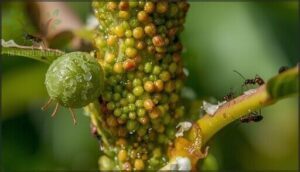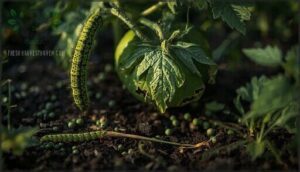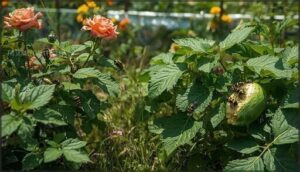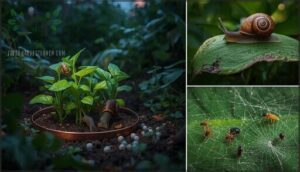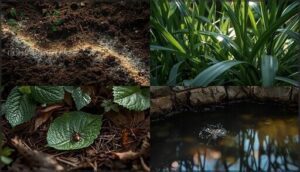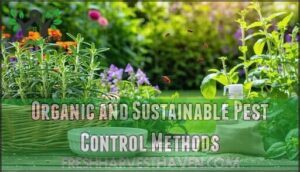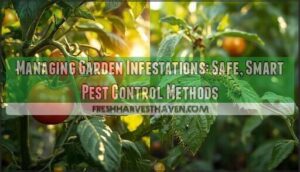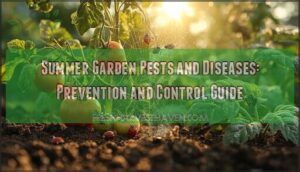This site is supported by our readers. We may earn a commission, at no cost to you, if you purchase through links.

The damage compounds quickly: what starts as a few punctured leaves escalates into skeletal plants and reduced harvests. Learning to identify and eliminate common garden pests means catching infestations early, understanding what you’re fighting, and using targeted methods that protect your plants without harsh chemicals.
The difference between a thriving garden and a struggling one often comes down to spotting trouble signs within the first 48 hours.
Table Of Contents
Key Takeaways
- Early detection through daily inspections—checking leaf undersides, stems, and soil within the first 48 hours—prevents 35-45% of garden damage and can save up to $1,500 per outbreak before infestations spiral out of control.
- Physical damage patterns reveal pest identity: large irregular holes signal caterpillars or slugs, skeleton leaves indicate Japanese beetles, stippling points to sap-feeders like aphids or mites, and frass plus webbing confirm active infestations requiring immediate targeted response.
- Layered prevention strategies work together—row covers boost yields 3.6x, companion planting with marigolds and nasturtiums diverts 40-50% of pest damage, crop rotation cuts soil-borne pests by 75%, and organic mulch suppresses 90% of weeds that harbor insects.
- Organic control methods deliver measurable results without chemicals: hand-picking reduces damage by 62%, beneficial insects like ladybugs eliminate 70% of aphid colonies within four weeks, and insecticidal soap or neem oil achieve 90-93% mortality rates against soft-bodied pests when applied correctly.
Spotting Common Garden Pest Damage
Your garden’s telling you a story—you just need to know how to read it. Damage patterns reveal which pests are feeding on your plants and how urgently you need to act.
Your garden speaks through damage patterns—learn to read them before pests take over
Let’s look at three telltale signs that help you identify the culprit before the problem spreads.
Recognizing Chewed Leaves and Holes
Chewed leaves tell a story. When you spot large, irregular holes, you’re likely looking at caterpillars or slugs—they remove significant leaf tissue, sometimes up to 40% in a single night. Japanese beetles create that distinctive “skeleton” look, leaving only the veins behind. Smaller, round shot holes point to flea beetles.
Check for frass beneath damaged leaves to confirm caterpillar activity, and look for mucous trails from slugs and snails. To identify the pest, research common nighttime feeding behaviors and patterns.
Identifying Discoloration and Wilting
Beyond holes, leaf discoloration and wilting patterns reveal pest identity. Stippling—pale spots from aphids, spider mites, or lace bugs—signals sap-feeding activity and can reduce photosynthetic capacity by 30%. Watch for these plant necrosis and wilting patterns:
- Vascular browning in stems indicates Fusarium wilt or bacterial infection, not drought
- Yellowing between veins (chlorosis) points to insect pests or viral pathogens
- Bronzing with sticky residue confirms aphid or whitefly infestations
- Sectoral wilting suggests bacterial wilt, with yield losses reaching 91% in tomatoes
- Halo rings around necrotic spots appear within 72 hours of pest-induced infection
Fungal diseases like powdery mildew peak in spring and autumn, affecting up to 35% of susceptible plants.
For effective pest management and plant protection, distinguish pest indicators from nutrient deficiencies—pest damage spreads irregularly, while abiotic stress creates uniform patterns. Early garden pest identification prevents widespread damage. Understanding the causes of leaf discoloration symptoms is essential for targeted interventions.
Noting Frass, Webbing, and Residue
Look for three types of physical evidence left behind by active infestations. Termite frass accumulates as one-millimeter pellets beneath kick-out holes, while lacebugs deposit varnish-like dark frass on leaf undersides during midsummer. Spider mites spin fine webbing that reduces airflow by up to 40%, creating humid microhabitats for fungal growth.
Frass analysis helps with insect identification—its color reflects consumed plant material, and hydrocarbon profiling can pinpoint specific beetle species. You’ll also notice thrips leave shiny, abraded residue patches that reflect light differently than healthy tissue.
This physical evidence bolsters accurate pest identification and guides your pest management decisions while improving soil fertility when frass decomposes naturally.
How to Identify Frequent Garden Pests
Once you spot damage, you need to know which pest is behind it. Each common invader leaves its own signature—from the soft clusters of aphids on new stems to the metallic gleam of Japanese beetles on your roses.
Let’s walk through the key culprits you’re likely to encounter this season.
Aphids—Appearance and Signs
Aphids rank as the top destructive soft-bodied pest, with over 60% of gardeners reporting infestations in recent seasons. You’ll recognize these tiny invaders by their soft, pear-shaped bodies measuring 1–4 mm long, clustering on tender new growth and undersides of leaves.
- Color varies widely: green, yellow, brown, black, or red depending on species
- White flaky skins accumulate on leaves from molted exoskeletons during growth
- Sticky honeydew residue coats foliage, attracting ants and causing black sooty mold
- Yellowing or curled leaves signal active feeding on plant sap
- Two tube-like projections extend from their rear—a key identifying feature
Caterpillars and Cutworms—Damage Patterns
Caterpillars devour foliage with surgical precision, while cutworms ambush seedlings at ground level. You’ll spot these garden pests through distinct feeding patterns and frass analysis that reveals their hidden activity—leaf defoliation from caterpillars averages 5.7–20% of total leaf area, though severe outbreaks cause complete stripping within weeks.
| Pest Type | Damage Assessment |
|---|---|
| Caterpillars | Jagged holes in leaves; dark frass pellets beneath plants; defoliation up to 40% annually |
| Loopers/Cankerworms | Complete leaf removal during outbreaks; 15–40% annual loss in oak and birch |
| Cutworms | Severed seedlings at soil level; 10–80% stand loss in patches; nocturnal stem cutting |
| Boring Caterpillars | Circular holes in stems; curled wood shavings (not sawdust); minimal external feeding |
Your pest management techniques start with monitoring feeding patterns—larger larvae like tomato hornworms produce conspicuous droppings near damage zones, while some species camouflage evidence within silk cases, complicating insect identification and control efforts.
Japanese Beetles and Cucumber Beetles
Two beetle species—metallic-green Japanese beetles and yellow-striped cucumber beetles—dominate garden monitoring reports in 2025, demanding distinct pest management approaches.
You’ll recognize them through:
- Japanese Beetles: 1/3 to 1/2 inch long with copper wings, five white hair tufts per side, feeding on 300+ plant species
- Cucumber Beetles: 1/4 inch with three black stripes or twelve spots, targeting cucurbits and transmitting bacterial wilt
- Damage Patterns: Leaf skeletonization from Japanese beetles versus stem/root feeding by cucumber beetle larvae
- Control Success: Aluminum-coated plastic and companion plants outperform chemical treatments, supporting organic controls and beetle resistance strategies
Insect identification and control start with tracking beetle life cycles—Japanese beetles complete development in one year underground, while cucumber beetles produce two to three generations annually.
Slugs, Snails, and Spider Mites
Moisture-loving slugs and snails, along with heat-thriving spider mites, represent contrasting garden pests that require targeted organic pest control approaches. You’ll spot slugs and snails by their silvery mucus trails and ragged leaf holes—2024 UK reports hit 1970s record highs, while California’s brown garden snail causes 70% of mollusk damage. Spider mites create fine webbing and leaf stippling, with 2024 U.S. greenhouse mite infestations jumping 27%.
| Pest Type | Key Identification & Control |
|---|---|
| Slugs | Nocturnal feeders consuming 10–40% of seedlings nightly; copper barriers block 80% of access |
| Snails | Brown garden snails show spiral shells; metaldehyde baits and hand-picking reduce populations 72% |
| Spider Mites | Microscopic arachnids thriving at 27–32°C; predatory mites (Phytoseiulus) cut numbers 65% |
| Barriers | Coarse mulch decreases slug access 60–75%; drip irrigation limits moisture that attracts mollusks |
Garden barriers and understanding pest life cycles—slugs overwinter as adults, mites complete generations in 7 days—form your foundation for effective snail behavior management and controlling mite infestations naturally.
Ants, Fleas, Ticks, and Mosquitoes
Beyond plant feeders, you’ll encounter ants, fleas, ticks, and mosquitoes—pests that threaten both garden health and human safety. Ant infestations affect 56% of U.S. households, while fleas, ticks, and mosquitoes spread diseases and disrupt outdoor comfort. Effective pest management strategies combine habitat modification with targeted treatments:
- Ants form trails to aphid colonies; diatomaceous earth disrupts paths by 70%
- Fleas breed in moist soil; nematodes reduce larvae populations 80% in lawns
- Ticks thrive near debris and forests; removing yard clutter cuts densities 30–40%
- Mosquitoes need standing water; eliminating sources every five days drops larvae survival below 10%
Addressing flea habitats through lawn maintenance and tick risk factors by clearing stone walls creates safer gardens. Ant control methods using citrus repellents and mosquito breeding prevention through Bti bacteria offer eco-friendly solutions for all-encompassing pest control.
Preventing Garden Pest Infestations
Prevention isn’t about reacting to pests—it’s about creating conditions where they can’t gain a foothold in the first place. The most effective strategies work together like layers of defense, each one reinforcing the others.
Here’s how to build that protection into your garden from the ground up.
Using Row Covers and Barriers
Row covers act as a physical shield between your plants and hungry pests. In University of Kentucky trials, breathable mesh materials boosted marketable yields by 3.6 times while blocking caterpillars, flea beetles, and thrips.
Proper barrier installation means anchoring edges firmly at soil level—this pest exclusion method stops overwintered insects before they reach your crops. These crop protection strategies cut pest pressure by 40 percent without chemical sprays.
Companion Planting and Trap Crops
Strategic companion planting acts like a neighborhood watch for your garden—certain plants actively deter pests from your vulnerable crops. Studies show polyculture benefits include 32 percent higher yields and 30 percent more beneficial predators patrolling your beds.
Proven companion planting strategies include:
- Marigolds near squash—repel aphids and bean beetles while boosting pollination
- Alliums around vulnerable crops—onions and garlic drive away Japanese beetles
- Nasturtiums as trap crops—divert aphids and caterpillars, protecting 40-50 percent more of your main harvest
Trap cropping allocates 5-20 percent of your plot to highly attractive pest magnets planted at field edges, concentrating damage away from your prized vegetables.
Maintaining Clean and Healthy Garden Beds
Clean garden beds stop pests before they settle in. Removing spent plants and debris at season’s end cuts overwintering pests by 75 percent. Weekly weeding blocks 80 percent of weed seed establishment, while 3-4 inches of organic mulch suppresses 90 percent of new weeds.
Sanitizing tools with mild bleach limits pathogen spread, and soil testing identifies nutrient gaps that weaken your plants’ defenses against garden pests.
Crop Rotation and Disease-Resistant Plants
Rotating your crops each season disrupts pest life cycles and cuts soil-borne pests by up to 75 percent. Alternating host and non-host plants—like switching corn with legumes—starves pathogens while improving soil health.
Pair rotation with disease-resistant varieties to reduce infestations by 60-90 percent, lower pesticide use, and support sustainable farming through natural pest suppression and soil renewal.
Organic and Sustainable Pest Control Methods
Once you’ve set up preventative measures, you’ll want reliable ways to manage pests without harsh chemicals.
The methods below offer effective, earth-friendly alternatives that protect your plants and the beneficial creatures sharing your garden space.
Each approach works differently, so you can mix and match based on what you’re dealing with.
Hand-Picking and Physical Removal
When pests slip past your defenses, manual pest control becomes your first line of attack. Hand picking Japanese beetles, caterpillars, slugs, and aphids into soapy water achieves impressive results—studies show daily removal reduces feeding damage by up to 62%. You’ll need just 10–15 minutes per 100 square feet.
This mechanical method works best on garden pests like hornworms and cutworms, cutting defoliation rates by 58% while supporting beneficial insects through pesticide-free pest disposal.
Introducing Beneficial Insects and Predators
Rather than relying on hand-picking alone, you can recruit nature’s pest controllers. Biological control methods using predator species like ladybugs, lacewings, and parasitic wasps cut pest populations by an average of 63%—often eliminating aphid colonies by 70% within four weeks.
These eco-friendly methods build sustainable ecosystems while reducing chemical dependence by 44%, creating insect habitats that support biological pest control year-round.
Using Insecticidal Soaps and Neem Oil
Targeted sprays work when beneficial insects aren’t enough. Insecticidal soap at 1.5–3% concentration kills up to 93% of soft-bodied garden pests like aphids and mealybugs on contact—just guarantee complete coverage since there’s no residual effect after drying.
Neem oil offers broader pest control with 90% reduction rates, disrupting insect development systemically.
Apply either treatment early morning or evening to prevent leaf burn, repeating every 4–7 days. Test on a small area first, as sensitive plants may show damage within three days.
DIY Pest Control Solutions
You can whip up effective botanical extracts right at home—garlic and chili sprays cut tomato hornworm damage by over 70%. Essential oils like black pepper and tea tree achieve 80–98% aphid mortality when combined.
Mix water, white vinegar, baking soda, and dish soap, applying three times weekly to reduce insect activity.
These organic formulas offer natural repellents without harsh chemicals, supporting sustainable garden pest management and insect control strategies.
Monitoring and Long-Term Garden Health
Keeping your garden healthy isn’t a one-time fix—it’s an ongoing relationship between you and your plants. Regular monitoring catches problems while they’re still manageable, and smart habits build resilience season after season.
Here’s how to stay ahead of pests and maintain a thriving garden long-term.
Regular Pest Inspections and Early Detection
Think of routine garden checks as your first line of defense—weekly Pest Inspection Frequency during growing season catches problems before they spiral. Early Detection Methods cut damage by 35-45% annually, and detecting pests early can save you up to $1,500 per outbreak.
- Use yellow sticky traps and magnifying lenses for thorough Garden Monitoring Tools inspection
- Check leaf undersides, stems, and soil for signs of Garden Pests and insect activity
- Document findings in a journal to track patterns and improve Pest Prevention timing
- Consider Automated Pest Tracking with Smart Pest Alerts for 24/7 surveillance and faster response
Soil Health and Smart Irrigation Practices
Healthy soil and controlled watering form the backbone of natural pest control. Organic amendments boost your soil microbiome—bacterial diversity jumps 27%, strengthening plant defenses and nutrient cycling. Smart irrigation systems slash water use by 40-70% while preventing the soggy conditions pests love. Fields with vigorous microbial activity saw 18% higher yields and sequestered up to 1.2 metric tons of CO₂ per hectare annually through carbon sequestration. Combining soil health management with water conservation cuts nutrient leaching by 29% and improves productivity by 22%, giving you stronger plants that naturally resist invasion.
| Practice | Impact on Garden Health |
|---|---|
| Organic compost application | Increases soil carbon 15-30% in five years |
| Smart drip irrigation | Achieves 95% water-use efficiency |
| Microbial inoculants | Reduces soilborne pathogens by 32% |
| Weather-based controllers | Saves 25,000 liters water per hectare yearly |
| Conservation tillage | Boosts aggregate stability by 31% |
Your organic gardening methods and consistent garden maintenance create resilient soil that works alongside you in the fight against garden pests.
Encouraging a Balanced Garden Ecosystem
A balanced garden ecosystem turns pest control into teamwork. Nearly 75% of global food crops depend on pollinators, while natural predators reduce pest populations by 73% and boost yields by 25%. Your organic gardening methods and integrated pest management strategies create resilient biodiversity conservation that works around the clock.
- Plant diverse native species to increase pollinator diversity and support beneficial insects by 40%
- Introduce predator habitats—gardens with mixed plantings achieve 2.5 times greater pest suppression
- Feed your soil microbiome with compost to strengthen plant defenses and ecosystem balance
- Create green corridors connecting garden zones to improve genetic flow and species movement
- Monitor weekly for early pest detection while letting natural predators maintain sustainable practices
Frequently Asked Questions (FAQs)
What attracts specific pests to my garden?
Ever wonder why pests zero in on your garden? Chemical signals like plant volatiles attract specific insects—aphids follow terpenoids, while slugs seek moisture-rich spots.
Environmental triggers, including temperature and soil moisture, drive pest attraction, alongside pheromone effects that lure mates and establish colonies.
How do weather conditions affect pest activity?
Weather shapes when and how garden pests attack. Temperature drives pest life cycles—aphids thrive at 20-25°C, while spider mites peak near 27°C. Heatwaves accelerate reproduction; cold snaps kill overwintering populations.
Rainfall and humidity boost insect survival, while drought weakens plants, making them vulnerable.
When is peak season for garden pests?
As spring transitions to summer, pest seasonality reaches its crescendo. Garden pests peak from late spring through summer when temperature thresholds of 20°C to 35°C and elevated humidity levels create ideal conditions for rapid reproduction and development across most regional variations.
Can pests develop resistance to organic treatments?
Yes, pests develop resistance to organic treatments through genetic adaptation and pest evolution. Target-site mutations and enhanced detoxification enzymes reduce treatment efficacy.
Integrated pest management and rotating organic pesticides help slow resistance mechanisms and maintain effective insect management in organic gardening.
How do I handle pest infestations on edible crops?
Prioritize safe pesticides like insecticidal soap or neem oil on edible crops. Hand-pick visible pests daily. Stop treatments 7–14 days before harvesting. Wash produce thoroughly.
Practice crop rotation to prevent recurring infestations and maintain garden health.
Conclusion
Protecting plants becomes progress when you identify and eliminate common garden pests before permanent damage sets in. That neighbor’s tomatoes didn’t recover—but yours will if you check leaf undersides daily, recognize early warning signs, and act within hours instead of days.
Pest control isn’t about chemical warfare; it’s pattern recognition paired with precise intervention. Your garden thrives when you stay vigilant, deploy targeted solutions, and build ecosystems where beneficial predators outnumber destructive invaders.
The harvest you save starts with the first inspection you conduct today.

